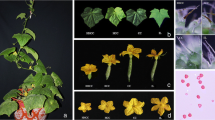Summary
Cajanus platycarpus, an incompatible wild species from the tertiary gene pool of pigeonpea (C. cajan (L.) Millspaugh), has many desirable characteristics for the improvement of cultivated varieties. To necessitate such transfers, embryo rescue techniques were used to obtain F1 hybrids. The F1 hybrids were treated with colchicine to obtain tetraploid hybrids, that were selfed to obtain F2, F3 and F4 progenies. All of the hybrids and subsequent progenies had an intermediate morphology between the two parents. Backcrossing of the tetraploid hybrids with cultivated pigeonpea was not possible given embryo abortion, with smaller aborted embryos than those obtained in the F0 parental cross.
As a route of introgression, diploid F1 hybrids were backcrossed with cultivated pigeonpea and BC1 progeny obtained by in vitro culture of aborting embryos. BC2 plants were obtained by normal, mature seed germination. Although embryo rescue techniques had to be used to obtain F1 and BC1 plants, it was possible to produce BC2 and subsequent generations through direct mature seed. Every backcross to cultivated pigeonpea increased pollen fertility and the formation of mature seeds.
Similar content being viewed by others
References
Brar, D.S. & G.S. Khush, 1997. Alien introgression in rice. Plant molecular biology 35: 35–47.
Dundas, I.S., 1996. Studies into overcoming some crossability barriers involving pigeonpea (Cajanus cajan (L.) Millsp.) and related Atylosia species. Project report 1984–86. International Crops research Institute for Semi Arid Tropics, Patancheru 502 324, India.
Mallikarjuna Nalini & J.P., Moss, 1995. Production of hyrids between Cajanus platycarpus and C. cajan. Euphytica 83: 43–46.
Mallikarjuna Nalini, 1998. Ovule culture to rescue aborting embryos from pigeonpea (Cajanus cajan L. Millspaugh) wide crosses. Indian Journal of Experimental Biology 36: 225–228.
Mallikarjuna Nalini & D.C. Sastri. 2002. Morphological, cytological and disease resistance studies of the intersectional hybrids between Arachis hypogaea L. and A. glabrata Benth. Euphytica 126(2): 161–167.
Mallikarjuna Nalini, 2003. Wide hybridization in important food legumes. In: P.K. Jaiwal and R.P. Singh (Eds.) Improvement Strategies of Leguminosae Biotechnology, pages 155–170. Kluwer Acad. Publishers.
Mallikarjuna Nalini & K.B. Saxena, 2005. A cytoplasmic male-sterility system derived from pigeonpea (Cajanus cajan (L) Millsp.) cytoplasm. Euphytica 142(1–2): 143–148.
Payne, R.W. 2002. The Guide to Gen Stat (R) Release 6.1. Part 2: Statistics. VSN International Ltd., Oxford. UK
Reddy, M.V., T.N. Raju & V.K. Sheila, 1996. Phytophthora blight disease in wild pigeonpea. International Chickpea and Pigeonpea Newsletter 3: 52–53.
Saxena, K.B., R.P. Ariyanayagam & L.J. Reddy, 1992. Genetics of a high selfing trait in pigeonpea. Euphytica 59: 125–127.
Saxena, K.B., M.V. Reddy, V.R. Bhagwat & S.B. Sharma, 1996. Preliminary studies on the incidence of major diseases and insects in Cajanus platycarpus germplasm at ICRISAT Asia center. International Chickpea and Pigeonpea Newsletter 3: 51–52.
Saxena, K.B., R.V. Kumar & P.V. Rao, 2000. Pigeonpea nutrition and its improvement. Genetic Resources and Enhancement Program, International Crops Research Institute for Semi Arid Tropics, Patancheru 502 324, Andhra Pradesh, India.
Saxena, K.B. & R.V. Kumar, 2003. Development of a cytoplasmic-nuclear male-sterility system in pigeonpea using C. scarabaeoides (L.) Thours. Indian J Genet 63(3): 225–229.
Subbarao G.V., 1988. Salanity tolerance in pigeonpea (Cajanus cajan) and its wild relatives. Ph.D. Dissertation, Indian Institute of Technology, Kharagpur, India.
Subbarao, G.V., 1988. Salinity tolerance in pigeonpea (Cajanus cajan) and its wild relatives. Ph.D., dissertation, Indian Institute of Technology, Kharagpur, India.
Author information
Authors and Affiliations
Additional information
Special project assistant till December, 2003.
Rights and permissions
About this article
Cite this article
Mallikarjuna, N., Jadhav, D. & Reddy, P. Introgression of Cajanus platycarpus genome into cultivated pigeonpea, C. cajan . Euphytica 149, 161–167 (2006). https://doi.org/10.1007/s10681-005-9063-6
Received:
Accepted:
Published:
Issue Date:
DOI: https://doi.org/10.1007/s10681-005-9063-6




